JOHN S. MASON - CONSERVATION
OF
WALES' MINERAL HERITAGE:
ROAD CUTTINGS AND QUARRIES
Note:
to return to the Conservation page of John Mason's main site, please
click on EXIT
at the bottom of any of these pages.
The construction of new
roads or
tracks in upland areas frequently exposes much bedrock and it follows
that there is a reasonable prospect of interesting mineralisation
coming to light. Some important discoveries have been made along track
sections in Wales, including the only decent exposures of the Coed Y
Brenin porphyry-copper orebody, which are now protected as SSSI's.
Working
quarries offer
a challenge in conservation terms but mineral suites may be conserved
by bulk removal ("rescue-collecting") of material to Museum geology
departments, where it can be preserved and studied at leisure. When a
quarry closes, if there is still important mineralisation on show, its
preservation can where safely practical be written in to the
post-closure plan.
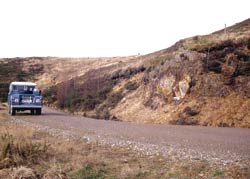 |
Here
is a prime example of a roadside exposure of metallogenic interest.
This is a forest road in Coed Y Brenin. It has been cut through
Cambrian sedimentary rocks and intrusions. Here, however, is a
boss-like area of harder rock... |
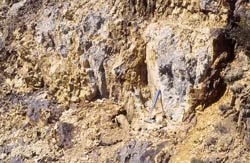 |
Closer
examination reveals an abundance of sintery quartz and fine-grained
pyrite... |
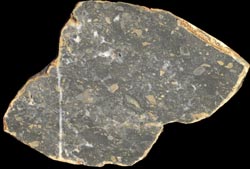 |
It
is a pipelike mass of brecciated rock cemented by silica and iron
sulphides. It is enriched in base-metals, gold, silver, arsenic and
antimony. |
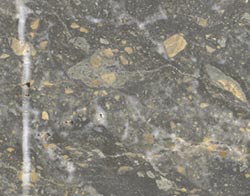 |
Here
is a close-up. Repeated brecciation is evident and the mineralisation
is texturally complex even under high magnification.
The pipe has been interpreted as a fossil fumarolic system,
representing the altered and mineralised zone through which superheated
waters passed upwards to exist as geysers upon reaching the surface.
The heat was supplied by the magma chamber which underlay the early
Ordovician Rhobell volcano, which at the time of formation would have
been somewhere overhead! This site is now a SSSI. |
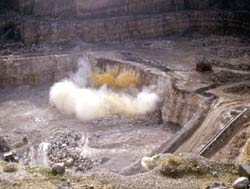 |
Blasting
at a quarry in Carboniferous Limestone, NE Wales. This area contains
many metal mines, the majority of which are so overgrown that their
mineralogical interest is difficult to assess without substantial
mechanised excavation. However, the working quarries freshly expose the
same mineralisation on a regular basis, making the collection of
unweathered sample suites a more realistic possibility. This quarry was
producing some fine azurite specimens in 1998 and many are now
preserved in the National Museum of Wales' mineral collection. |
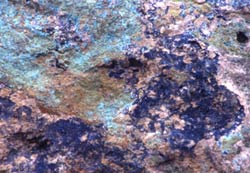 |
Azurite (dark blue) and
the copper
arsenate tyrolite (light blue) in situ at Dolyhir Quarry, on the Welsh
Border, 1996. The quarry works Wenlock Reef Limestone and the
underlying Longmyndian (Precambrian) sedimentary rocks. A series of
Cu-Pb-As-Ba dominated veins cuts through the sequence.
This
short-lived
exposure was studied and sampled extensively and produced a great
diversity of different minerals, both primary and secondary. Prior to
the area's removal by quarrying, many tens of kilogrammes of samples
were preserved. The mineralisation is highly complex and studies will
be ongoing for some time to come. |
MINES
NATURAL
EXPOSURES
EXIT
|





